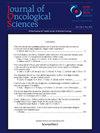{"title":"Intravesical Bacillus Calmette-Guérin Reduces Lung Involvement in COVID-19 in Patients with Bladder Cancer","authors":"M. S. Özkent, Y. E. Göger, Nurullah Altınkaya, M. Artaç","doi":"10.37047/jos.2022-91733","DOIUrl":null,"url":null,"abstract":"Objective: To compare the coronavirus disease-19 (COVID-19) infection, morbidity, and mortality rates of patients who did not receive and received Bacillus Calmette-Guerin (BCG) treatment because of bladder cancer during the COVID-19 pandemic. Material(s) and Method(s): Patients who were followed up for bladder cancer between March 2019 and March 2021 were evaluated. Patients who underwent intravesical BCG instillation (induction or maintenance) and those who did not receive BCG were divided into two groups. The characteris-tics (age, gender, etc.) and COVID-19-related findings (symptoms, comorbidities, lung involvement, and need for patient admission) of the patients were recorded and compared between the groups. Result(s): The present study included 215 patients (85 in Group 1;and 130 in Group 2). Demographic data were similar in both groups (body mass index, age, gender, comorbidities, etc.). COVID-19 incidence was similar in both groups (18 patients in Group 1;21 patients in Group 2;p: 0.350). The number of patients with COVID-19 treated in the hospital was more in Group 1 than in Group 2 (14 patients in Group 1, 7 patients in Group 2, p: 0.006). However, lung involvement and dyspnea were significantly lower in the intravesical BCG Group (p: 0.015;and p: 0.001, respectively). Conclusion(s): Intravesical BCG instillation reduces the morbidity associated with COVID-19. Therefore, the installation schemes should not be delayed due to the pandemic. The current study im-parts preliminary information about the importance of BCG vaccination studies against COVID-19. Copyright © 2022 by Turkish Society of Medical Oncology.","PeriodicalId":31838,"journal":{"name":"Journal of Oncological Sciences","volume":"1 1","pages":""},"PeriodicalIF":0.0000,"publicationDate":"2022-01-01","publicationTypes":"Journal Article","fieldsOfStudy":null,"isOpenAccess":false,"openAccessPdf":"","citationCount":"0","resultStr":null,"platform":"Semanticscholar","paperid":null,"PeriodicalName":"Journal of Oncological Sciences","FirstCategoryId":"1085","ListUrlMain":"https://doi.org/10.37047/jos.2022-91733","RegionNum":0,"RegionCategory":null,"ArticlePicture":[],"TitleCN":null,"AbstractTextCN":null,"PMCID":null,"EPubDate":"","PubModel":"","JCR":"Q4","JCRName":"Medicine","Score":null,"Total":0}
引用次数: 0
膀胱内卡介苗-谷氨酰胺可减少膀胱癌患者COVID-19对肺部的损害
目的:比较2019冠状病毒病(COVID-19)大流行期间膀胱癌患者未接受与接受卡介苗(Bacillus calmetet - guerin, BCG)治疗的患者的感染情况、发病率和死亡率。材料和方法:对2019年3月至2021年3月随访的膀胱癌患者进行评估。接受膀胱内卡介苗注射(诱导或维持)和未接受卡介苗注射的患者分为两组。记录两组患者的特征(年龄、性别等)及与covid -19相关的发现(症状、合并症、肺部受累、住院需求)并进行比较。结果:本研究纳入215例患者(1组85例,2组130例)。两组的人口统计学数据(体重指数、年龄、性别、合并症等)相似。两组患者的发病率相似(1组18例,2组21例,p: 0.350)。1组住院治疗的新冠肺炎患者多于2组(1组14例,2组7例,p: 0.006)。然而,膀胱内卡介苗组肺部受累和呼吸困难明显降低(p: 0.015; p: 0.001)。结论:膀胱内注射卡介苗可降低COVID-19相关的发病率。因此,安装计划不应因大流行病而推迟。目前的研究提供了部分关于卡介苗接种研究抗COVID-19重要性的初步信息。版权所有©土耳其肿瘤医学学会2022。
本文章由计算机程序翻译,如有差异,请以英文原文为准。


